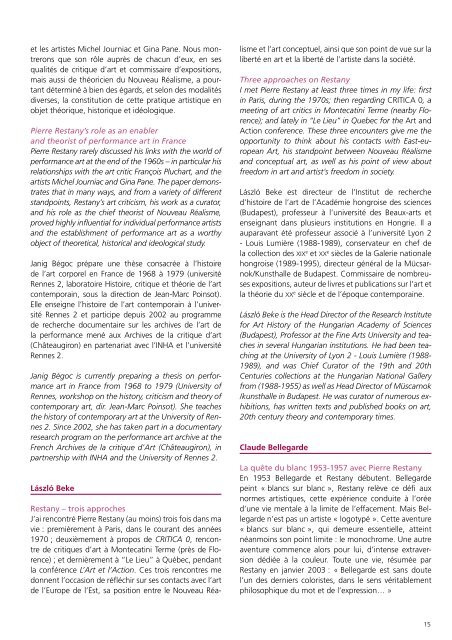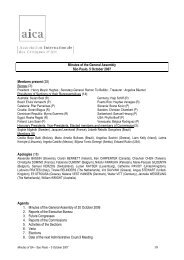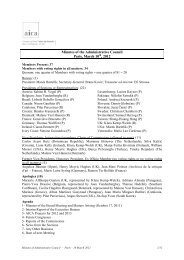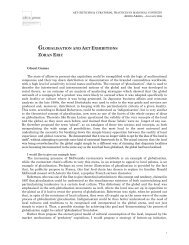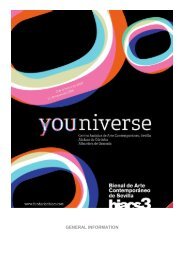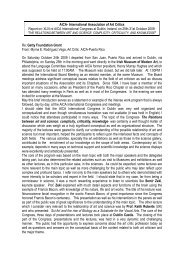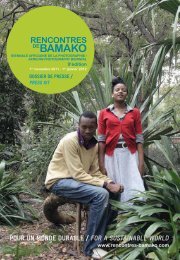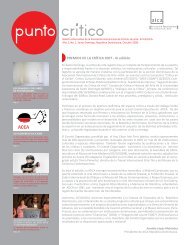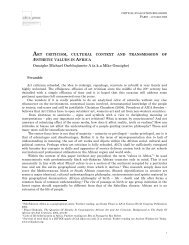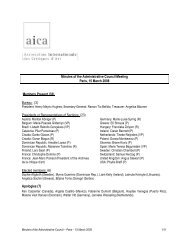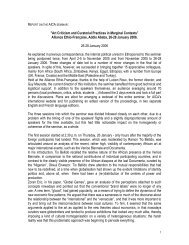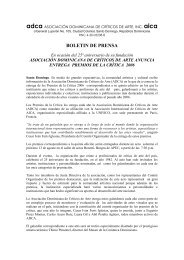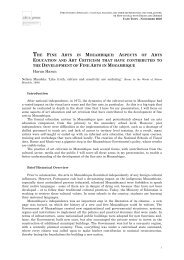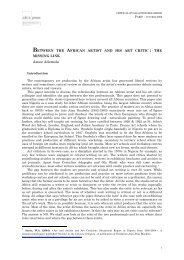Pierre Restany Pierre Restany's - AICA international
Pierre Restany Pierre Restany's - AICA international
Pierre Restany Pierre Restany's - AICA international
You also want an ePaper? Increase the reach of your titles
YUMPU automatically turns print PDFs into web optimized ePapers that Google loves.
et les artistes Michel Journiac et Gina Pane. Nous montrerons<br />
que son rôle auprès de chacun d’eux, en ses<br />
qualités de critique d’art et commissaire d’expositions,<br />
mais aussi de théoricien du Nouveau Réalisme, a pourtant<br />
déterminé à bien des égards, et selon des modalités<br />
diverses, la constitution de cette pratique artistique en<br />
objet théorique, historique et idéologique.<br />
<strong>Pierre</strong> <strong>Restany</strong>’s role as an enabler<br />
and theorist of performance art in France<br />
<strong>Pierre</strong> <strong>Restany</strong> rarely discussed his links with the world of<br />
performance art at the end of the 1960s – in particular his<br />
relationships with the art critic François Pluchart, and the<br />
artists Michel Journiac and Gina Pane. The paper demonstrates<br />
that in many ways, and from a variety of different<br />
standpoints, <strong>Restany</strong>’s art criticism, his work as a curator,<br />
and his role as the chief theorist of Nouveau Réalisme,<br />
proved highly influential for individual performance artists<br />
and the establishment of performance art as a worthy<br />
object of theoretical, historical and ideological study.<br />
Janig Bégoc prépare une thèse consacrée à l’histoire<br />
de l’art corporel en France de 1968 à 1979 (université<br />
Rennes 2, laboratoire Histoire, critique et théorie de l’art<br />
contemporain, sous la direction de Jean-Marc Poinsot).<br />
Elle enseigne l’histoire de l’art contemporain à l’université<br />
Rennes 2 et participe depuis 2002 au programme<br />
de recherche documentaire sur les archives de l’art de<br />
la performance mené aux Archives de la critique d’art<br />
(Châteaugiron) en partenariat avec l’INHA et l’université<br />
Rennes 2.<br />
Janig Bégoc is currently preparing a thesis on performance<br />
art in France from 1968 to 1979 (University of<br />
Rennes, workshop on the history, criticism and theory of<br />
contemporary art, dir. Jean-Marc Poinsot). She teaches<br />
the history of contemporary art at the University of Rennes<br />
2. Since 2002, she has taken part in a documentary<br />
research program on the performance art archive at the<br />
French Archives de la critique d’Art (Châteaugiron), in<br />
partnership with INHA and the University of Rennes 2.<br />
László Beke<br />
<strong>Restany</strong> – trois approches<br />
J’ai rencontré <strong>Pierre</strong> <strong>Restany</strong> (au moins) trois fois dans ma<br />
vie : premièrement à Paris, dans le courant des années<br />
1970 ; deuxièmement à propos de CRITICA 0, rencontre<br />
de critiques d’art à Montecatini Terme (près de Florence)<br />
; et dernièrement à “Le Lieu” à Québec, pendant<br />
la conférence L’Art et l’Action. Ces trois rencontres me<br />
donnent l’occasion de réfléchir sur ses contacts avec l’art<br />
de l’Europe de l’Est, sa position entre le Nouveau Réa-<br />
lisme et l’art conceptuel, ainsi que son point de vue sur la<br />
liberté en art et la liberté de l’artiste dans la société.<br />
Three approaches on <strong>Restany</strong><br />
I met <strong>Pierre</strong> <strong>Restany</strong> at least three times in my life: first<br />
in Paris, during the 1970s; then regarding CRITICA 0, a<br />
meeting of art critics in Montecatini Terme (nearby Florence);<br />
and lately in “Le Lieu” in Quebec for the Art and<br />
Action conference. These three encounters give me the<br />
opportunity to think about his contacts with East-european<br />
Art, his standpoint between Nouveau Réalisme<br />
and conceptual art, as well as his point of view about<br />
freedom in art and artist’s freedom in society.<br />
László Beke est directeur de l’Institut de recherche<br />
d’histoire de l’art de l’Académie hongroise des sciences<br />
(Budapest), professeur à l’université des Beaux-arts et<br />
enseignant dans plusieurs institutions en Hongrie. Il a<br />
auparavant été professeur associé à l’université Lyon 2<br />
- Louis Lumière (1988-1989), conservateur en chef de<br />
la collection des xix e et xx e siècles de la Galerie nationale<br />
hongroise (1989-1995), directeur général de la Mücsarnok/Kunsthalle<br />
de Budapest. Commissaire de nombreuses<br />
expositions, auteur de livres et publications sur l’art et<br />
la théorie du xx e siècle et de l’époque contemporaine.<br />
László Beke is the Head Director of the Research Institute<br />
for Art History of the Hungarian Academy of Sciences<br />
(Budapest), Professor at the Fine Arts University and teaches<br />
in several Hungarian institutions. He had been teaching<br />
at the University of Lyon 2 - Louis Lumière (1988-<br />
1989), and was Chief Curator of the 19th and 20th<br />
Centuries collections at the Hungarian National Gallery<br />
from (1988-1955) as well as Head Director of Müscarnok<br />
/kunsthalle in Budapest. He was curator of numerous exhibitions,<br />
has written texts and published books on art,<br />
20th century theory and contemporary times.<br />
Claude Bellegarde<br />
La quête du blanc 1953-1957 avec <strong>Pierre</strong> <strong>Restany</strong><br />
En 1953 Bellegarde et <strong>Restany</strong> débutent. Bellegarde<br />
peint « blancs sur blanc », <strong>Restany</strong> relève ce défi aux<br />
normes artistiques, cette expérience conduite à l’orée<br />
d’une vie mentale à la limite de l’effacement. Mais Bellegarde<br />
n’est pas un artiste « logotypé ». Cette aventure<br />
« blancs sur blanc », qui demeure essentielle, atteint<br />
néanmoins son point limite : le monochrome. Une autre<br />
aventure commence alors pour lui, d’intense extraversion<br />
dédiée à la couleur. Toute une vie, résumée par<br />
<strong>Restany</strong> en janvier 2003 : « Bellegarde est sans doute<br />
l’un des derniers coloristes, dans le sens véritablement<br />
philosophique du mot et de l’expression… »<br />
15


